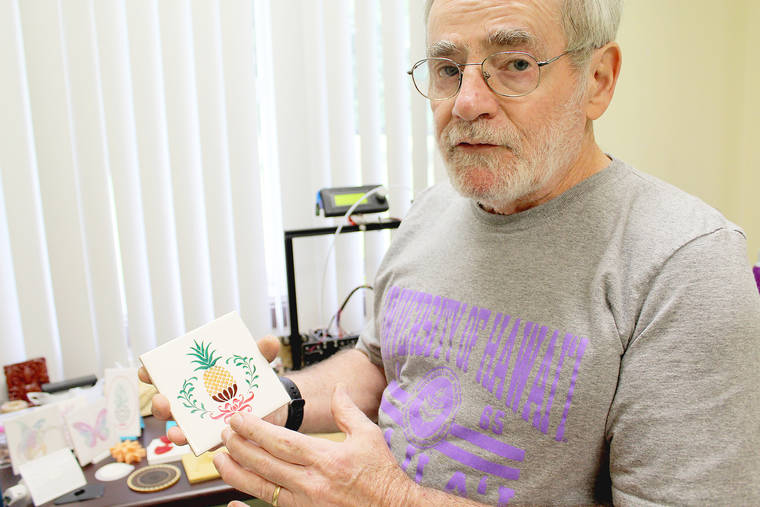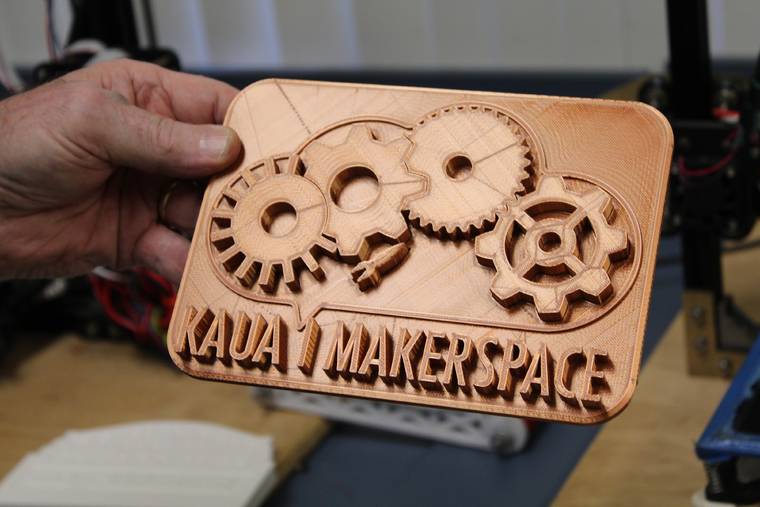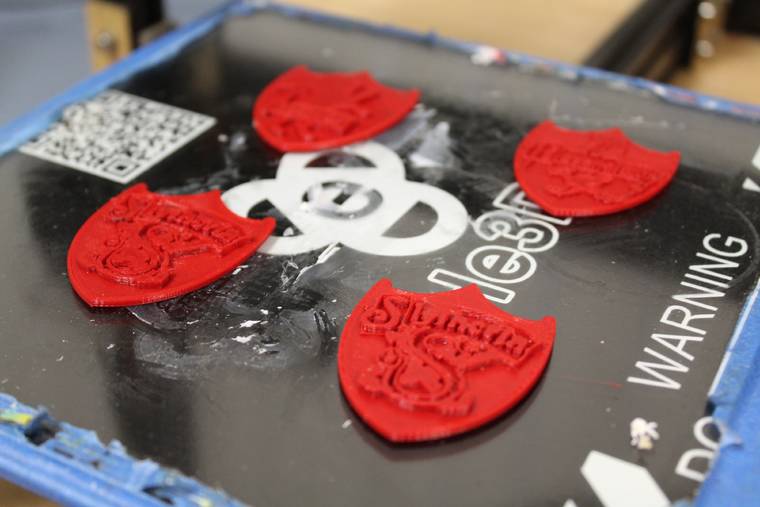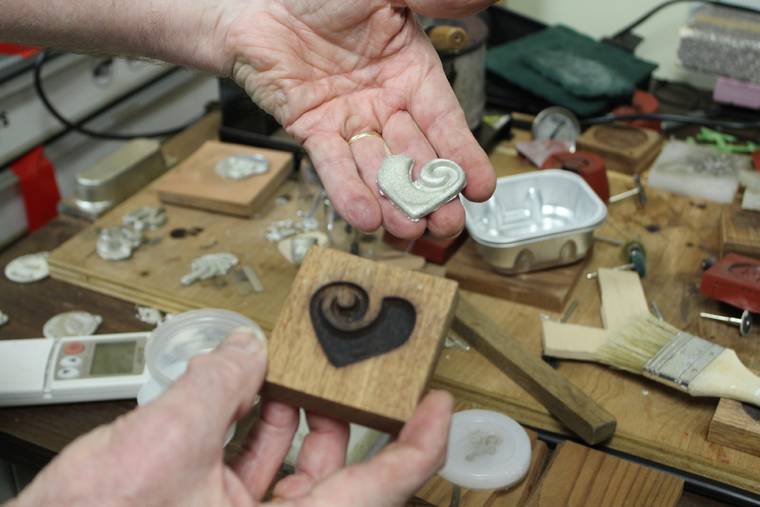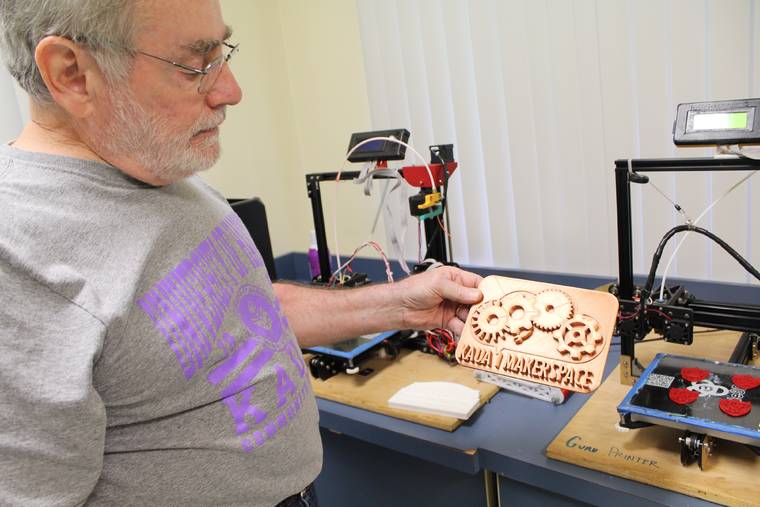Between a tiny house prototype and a large breadfruit tree in Puhi is a building where Kauai’s tinkerers and techies, hobbyists and laymen come to make things.
About a dozen 3D printers are abuzz in two different rooms, creating molds and models, ornaments, figurines and anything else a person could imagine. Lasers and routers are on hand for fashioning exquisite and detailed plaques, signs and other wooden items. There’s a metalworking station that makers use to create pewter jewelry, medals and figurines.
It’s a meeting of the minds that’s produced sumobots and prosthetic limbs, working fidget spinners and nightlights.
Kauai Makerspace started with a few dedicated tinkerers gathered around tables in Kauai Beer Company’s wave room or at Ha Coffee more than five years ago. They met together to discuss all of their own ongoing projects, but also to figure out how to recruit more members and start sharing their capabilities with the community.
In 2015, Rich O’Reilly came onto the scene, a retired engineer who worked for the National Aeronautics and Space Administration for 13 years. He moved to Kauai to support his son’s growing family and found another family within Makerspace shortly after arriving on-island.
Now, O’Reilly teaches classes for Makerspace five days a week and is always around the Innovation Center, the group’s headquarters at Kauai Community College. He recently sat down with The Garden Island to talk about Makerspace and the opportunities the organization offers.
TGI: Tell us the story of how Makerspace started and how you got involved.
O’Reilly: It was started before I got here. I got here five and a half years ago. At that time, I didn’t even know what Makerspace was. I was looking into 3D printing and wanted to share my stuff with likeminded people, so I went online looking for 3D printers, people that were doing it, on the island. Couldn’t find a lot of people and then I stumbled onto Makerspace. At that time they didn’t even have a place, it was mostly at Kauai Beer and Ha Coffee, meeting to decide what we were going to do.
Then Carl was ambitious and he did a whole tour of the island. He went to every library with a 3D printer and did a talk and showed people what it was about. Kapaa Library asked him to come on a regular basis.
He started coming every Tuesday. At that point there was one printer, built from a kit. My first printer cost me $3,500. Expensive. So, I bought a kit for $200 and I built it and we got it going. Then we tweaked it and enhanced it, and it was just as good as the $3,500 printer. I started thinking, others could do this.
The nice thing about Makerspace is we’ve all got different talents. When I first plugged the printer in that I built, it didn’t do anything. I’m electronically challenged. What am I going to do? I gave Kevin a call. He’s a whiz with this stuff and he came over and fixed it.
There’s nothing like making some challenging thing and showing it off. I can only do that with my wife so many times. Before she’s like: “well, what do you want for supper?”
To have someone else say, “Man, that’s cool! How do you do that?” And then to show them how, and then to have them say: “you know what, try this,” it’s better.
TGI: Tell us more about these sumobots you mentioned.
O’Reilly: So, we made some sumobots. What you do is you take about a three-foot disc and put it on the floor and take two little robots that bash each other like sumo wrestlers. Whoever stays on the disc, wins. We try not to destroy them, too much work involved.
What we made was basically a radio-controlled car. We made up about 10 of them and had the kids messing with them at different shows. We learned a lot because they beat the heck out of them. They busted them all up, so we learned how to make them stronger. Next, we figured, well, let’s make it programmable with sensors and lasers. Let’s give the kids a course and challenge them to see who can get through it first. So we’re in the middle of that. That’s going to take a while actually.
TGI: How do people get involved at Makerspace?
O’Reilly: It’s $20 a month to be a member. Then, you’ve got access to everything here. Anyone over the age of 10 is welcome and we’re always looking for new members. We’re looking for adults to teach classes, too. Always interested in people that want to share their knowledge with like-minded people, tinkerers and what have you, like me and these guys (Here, Rich points to a handful of other “tinkerers” hanging around the 3D printers. One is fashioning a pencil sharperner housing. Another is typing away at a keyboard).
So upcoming, we’ve put together a few classes and what they’re calling “make and take” classes. On Wednesdays once a month we’re doing a techie for adults class, trying to get some of the silver seniors to come over. I’m already a senior. It’ll be lightweight cool stuff, the lithopanes (detailed .jpeg photos 3D printed on whatever you want, illuminated with a light behind the image), coloring some tiles, casts, cool stuff.
Then we’ll have techie arts and crafts on Saturdays, one Saturday a month, and families can come in and “make and take.” Finish it and then come back Tuesday when I’m open and pick it up.
Every Wednesday from 3:30 to 6:30 is the kids’ camp and then kinda let them pick what they want to do. These kids are well-behaved and really focused. They want to be here. It’s a STEM thing and they want to do it. They come all the way from the North Shore so the moms are sitting in traffic in Kapaa. Dedicated moms.
I’m going to schools, too. I’ve been working with Wilcox Elementary two days a week, fourth and fifth graders and these kids are amazing. There’s 18 kids in the class. So I showed the kids how to make a 3D printed tag for luggage or their backpack. Then we got them to imagine and design their own stuff. They design it, and then send it to me because on the software you can share files. And then I print it for them. The first time I got 40 pieces to print. So, then I did another 40 or 50 and now I’m still getting emails from them.
Then I also work with Kauai High and I do a class with the juniors and seniors, an intro class. Soon, I’m going to do two classes with Waimea Canyon Middle School, too.
Just yesterday, we did a class with these kids and it’s so adorable to see them. I love it because we’ve got two teachers in the class and me and 18 kids. Kids put their hands up and the teachers say, “Just a minute,” and they say, “No, I need Mr. O‘Reilly.” That makes me think this is working good. It’s fun.
It keeps me busy five days a week and my wife is very forgiving. She won’t let me do another day, though.
TGI: Before you got to Kauai, you worked with NASA. How did you get that job and what was that like?
O’Reilly: I started out as a machinist and went to a mold maker. Then I ran a mold shop and then became a designer. Then I started teaching adults evenings and I had some people in aerospace sit in my classes.
They said “Would you mind coming down and talking to my boss?” I ended up contracting with them and finally they lured me into working full time. The last 13 years I was with aerospace.
What we were were doing, it’s a dirty word right now. We were doing the large optics like the 30-meter telescope. I was doing all the experimental stuff, I wasn’t the lead of anything. I was doing work for JPL, the Jet Propulsion Lab.
Then we started getting into flight hardware and what have you. Flight hardware, if you make this it takes you a day to draw it and design it and make it and then you have a pile of paperwork to go with it when it comes to NASA. The paperwork weights more than the object. What was nice is I was the front end leader and I could do all prototype stuff. I got away without doing all this paperwork because everything I was doing was research and development.
I had to do some reports but I didn’t have to have all these documents they had to do. A lot of the time I could avoid all that and I could just keep my hands in the project.
I retired and then I came here. I moved here because my son was here and got married and had two kids. He was a teacher here and the year I retired, his wife was getting ready to have their second baby. She was having some difficulty and I was able to fly out and hang out and take care of the boy, who is a couple years older while momma was on bed rest. I just loved it. And then when the baby came, my wife said that’s it, we gotta go. So we moved here. Two years later they had to move because they couldn’t afford to be here. They’re in Oregon. They asked us to move with them, but we’re not leaving Kauai. But, that’s where I’m going for Christmas.
